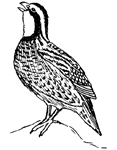Papers in the Biological Sciences

Grouse and Quails of North America by Paul A. Johnsgard
Date of this Version
5-8-1973
Document Type
Supplemental Material
Abstract
The three following keys can be used to identify unfamiliar species of North American grouse or quails that may be examined in the hand. Unless one is certain that the bird represents either a grouse or a quail, he should begin with the first key. The procedure, as in the use of all such keys, is to choose which of the two initial alternative descriptive couplets (A and AA) best fits the unknown bird. Having chosen one of these, proceed to the choice of couplets (B and BB) occurring immediately below the couplet chosen, without further regard for descriptions listed below the rejected alternative. After making a varying number of such choices in the first key, the reader will have identified his bird as to its major taxonomic group (family, subfamily, or tribe). If it belongs to either of the subfamilies of grouse or quails, the following two keys may be used to identify the specimen as .to its species. These two keys operate in the same fashion as does the first, by the reader starting again with the choice of couplets A and AA and proceeding until the bird has been identified as to species. Measurements, where they are given, refer to adult birds, but in general the keys have been devised in a manner that will allow for identification regardless of the specimen's sex or, within limits, its age.


Comments
From Grouse and Quails of North America, by Paul A. Johnsgard (Lincoln, NE, 1973 & 2008). Electronic edition copyright © 2008 Paul A. Johnsgard.